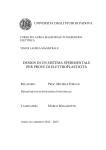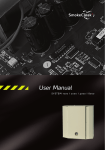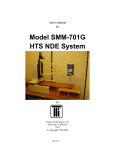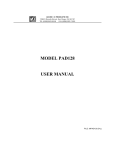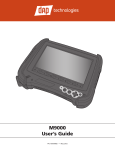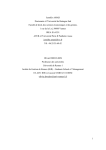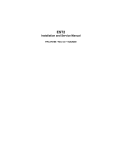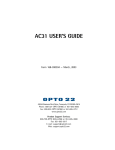Download Machine state virtualizer
Transcript
US005442542A United States Patent 1191 [11] [45] Cook [54] MACHINE STATE VIRTUALIZER [76] Inventor: Steven R. Cook, 2575 S. Bayshore Dr., Suite 8A, Coconut Grove, Fla. 33133 [21] Appl. No.: 700,705 [22] Filed: May 16, 1991 [51] Int. Cl.6 ............................................ .. GOSB 19/02 [52] US. Cl. ............................. .. 364/140; 364/709.01; [58] Field of Search .............................. .. 364/140-147, 364/709.11 364/191, 709.14, 709.15, 709.11, 709.09, 709.12, ' [56] 709.13, 709.16, 709.01; 370/60 References Cited U.S. PATENT DOCUMENTS Patent Number: Date of Patent: 5,442,542 Aug. 15, 1995 National Semiconductor, CMOS Logic Databook, pp. 5-56, 1988. Omega Engineering, Inc., “AT-DIO-32F” The Data Acquisition and Control Handbook Catalogue, pp. D-62-D-64, 1990. Micromint, BCC180 brochure, “Catalog of Embedded Controllers”, pp. 16-17, 1991. “Crosspoint Switches Seek Bandwidth”, EDN, Mar. 21, 1991, p. 3. Morgan, Don, “Understanding the GPIB”, Dr. Dobb’s Journal, pp. 48, 50, 52-53, and 92, Apr., 1991. Liebson, Steve, The Handbook of Microcomputer Inter facing, 2nd Edition, pp. 144-179. Tandy Corporation, Realistic Service ManuaL PRO-2006 Programmable Scanner, Catalogue No.: 20-145/9145, pp. 5, l7, and 77-78, 1990. Primary Examiner--Roy N. Envall, Jr. Assistant Examiner-Thomas E. Brown 2/ 1986 Chan ................................. .. 364/143 Attorney, Agent, or Firm-Evenson, McKeown, 4,672,602 6/1987 Hargrave et a1. . . . . Edwards & Lenahan 4,679,135 7/1987 Kobayashi et a1. .... .. 364/146 4,757,463 7/ 1988 Ballou et a1. . 395/905 4,570,216 . . . .. 370/58 5,144,548 9/1992 Salandro 364/191 [57] ABSTRACI‘ OTHER PUBLICATIONS A machine state virtualizer is an apparatus for control ling an electronic device having a switch matrix of X-lines and Y-lines (sometimes referred to as crosspoint switches) with a microcomputer. The device includes a Datametrics, Inc., “Communications Manager” bro lines and Y-lines of the electrical device. A microcom chure, 1989. Electronic Equipment Bank, 1 990 EEB Shortwave Cata log, pp. 10-11, 1990. Keithley, MCPT-SX8 Metrabus Crosspoint Matrix Relay Boards, “Data Acquisition Land Control” Catalogue, vol. 24, p. 238, 1991. Harris Semiconductor/RCA Solid State, puter references a machine state virtualization map and outputs data corresponding to a desired machine state. The output data is then decoded and used to control the plurality of switches so as to virtualize the desired ma chine state of the electronic device. The microcomputer utilizes sequences and rules for implementing a de?ned 5,179,552 l/l993 Chao 5,249,115 9/1993 Reid .................................. .. 364/141 ... .. . . . .. 370/60 plurality of switches which interconnect speci?ed X device control objective. “CD54/74HC22106, CD54/74HT22106” brochure, 3 Claims, 6 Drawing Sheets Jul. 1985. X-SWITCH ARRAY 4 X-SWITCH DEVICE SELECTOR 2 > X~SWITCH POLES 6 Y_SWITCH ARRAY 5 Y-SWITCH POLES 7 MICRO COMPUTER 1 Y-SWITCH DEVICE SELECTOR 3 / N e-—-— TPl FEEDBACK DEVICE 8 US. Patent Aug. 15, 1995 Sheet 3 0f 6 5,442,542 Yum mU; US. Patent Aug. 15, 1995 S‘i'i \ Sheet 5 of 6 Initialize 5T2 \ Set Next Frequency \ (see Device Driver) 3T3 Wait F or \ Minimum Duration ST4 \ Signal Detected Yet Duration Elapsed ? No Fig 4a 5,442,542 US. Patent Aug. 15, 1995 Sheet 6 of 6 5,442,542 / ST6 Start Select Next Data Word / ST7 In Frequency ST8 Data / / ST9 /STlO . Lookup Output Words All State For Data Processed Word From Mop Write/Latch 7 Selected X-Y Switches Yes Set tlo time Elapsed ’) SW2 \ Clear Switch Data / sm l___,___ Continue Main Program Sequence Fig 4b 1 5,442,542 MACHINE STATE VIRTUALIZER 2 puter. Accordingly, the device of this invention has widespread applications and can be used to control any electrical device which uses switches or responds to BACKGROUND OF THE INVENTION devices typically are provided with switches to enable a user to manually initiate and control their various appli cations. logic states. However, one speci?c advantageous use of the device of this invention is the use thereof to control radio devices. A typical electronic device incorporates an elec tronic keypad having an X-Y network of switches (sometimes referred to as a crosspoint switch network). The X-Y lines are interconnected by keystrokes, and data is generated thereby and forwarded to other blocks Generalized process control according to the prior art usually involves limited switching of electrical de of the device through simple logic state switching, pulse coded switching and other strategies. Depending upon vices (e.g., a heater is turned on via a relay if tempera ture falls to a certain level). Such control strategies typically employ a device controller such as the 8255 the device, the X-Y switch network may be used to input data to a microcontroller. The signals switched by Device and process control in prior art electronics applications is generally achieved through special pur pose circuitry using either simple gate logic or more complex microprocessor controllers. Such prior art the keypad may include non-standard states and/or programmable peripheral controller and the necessary timed pulses, thus rendering simple logical control unre hardware and software drivers. Thus, a logic state con trols a semiconductor or mechanical relay which in turn switches a control voltage. Such a design is acceptable if the device to be controlled is engineered to respond to liable. The device of this invention overcomes the unre simple logic signals, or has simple control needs which liability by connecting directly to the X-Y circuits and, under microcomputer control, by virtualizing the key strokes for which an electronic device was designed. BRIEF DESCRIPTIONS OF THE DRAWINGS can be accommodated through patterns of parallel data. However, such a control design is not acceptable for FIG. 1a is a block diagram of a ?rst preferred em situations wherein control of large numbers of states is 25 bodiment of the invention; necessary, for control of analog applications, or for FIG. lb is a block diagram of a second preferred control of more complex switch strategies such as non embodiment of the invention; standard states and time-sensitive requirements. FIG. 2 is a schematic diagram of a speci?c implemen In certain specialized ?elds there are standards and tation of the device of the invention according to the conventions governing the interaction among various 30 ?rst preferred embodiment; devices engineered to conform to these standards. For FIG. 3 shows an exemplary keypad logic analysis example, IEEE 488 is a recognized standard for inter map; . device communication. Other examples of such stan FIG. 4a is an exemplary ?owchart of the main pro dards are MIDI, which is used for control of musical gram sequence; and instruments, and the proprietary CI-V standard pub 35 FIG. 4b is an exemplary ?owchart of the device lished by ICOM America for the control of radio de driver sequence. vices. Most devices which are part of such a con?gura tion are generally also controllable through switches DETAILED DESCRIPTION and similar means. Unfortunately, these existing stan According to the ?rst preferred embodiment of the dards and the associated control schemes require spe 40 invention, four X-switch poles 6 and eight Y-switch cialized engineering of the electrical device and adher poles 7 are hard-wired to the X-Y circuits of an elec ence to rigorous pre-set standards. tronic device to be controlled. As shown in FIG. 1a, an Basic multiplexer techniques have been developed X-switch array 4 is provided to electronically switch for applications such as the computer data/control bus, audio/video switching, and telephonic switching, how 45 each of the X-switch poles to a common line TP1. Simi— ever, such devices and the necessary software and pro cesses have not been developed for general device and process control. Because of the lack of a universal standard for device larly, a Y-switch array 5 is provided to electronically switch each of the Y-switch poles to the common line control, and because of the multiplicity of machine functions, intended users and disparate design strate gies, a unifying approach for the control of electronic devices is unknown in the prior art. crocomputer 1 through X-switch device selector 2 and Y-switch device selector 3, respectively. The mi TPl. Electronic control of the X-switch array 4 and Y-switch array 5 is effected under the control of a mi crocomputer 1 provides control signals representative of machine states of the device to be controlled, and forwards these control signals to the device selectors. SUMMARY OF THE INVENTION 55 The device selectors then decode these control signals and control the individual switching of the switch ar The device of this invention overcomes the disadvan rays thereby. A feedback device 8 is provided which tages of the prior art discussed above and allows a uni provides a feedback signal from the electronic device to versal approach to device control by interaction with the microcomputer 1. the device’s own switches and existing control facilities, A second preferred embodiment of the invention is and by use of the device’s own signal levels and timings. shown in FIG. 1b, wherein corresponding elements The control infrastructure of the device of this inven from FIG. 1a are denoted by the same reference numer tion initiates and manages the controlled device, not als. In the second preferred embodiment, the device through imposing external control events as in the prior selectors are replaced by a switch selector/latch 9 art, but by virtualizing the very events for which the 65 which controls a 32-unit electronic X-Y switch array machine was designed. 10. The X-Y switch array 10 implements a switch ma The device of this invention is a generalized interface trix of the eight Y-switch poles 7 and the four X-switch which implements state switching, electronic device poles 6. Thus, electrical interconnection between any control, and related applications using a microcom 3 5,442,542 Y-switch pole and any X-switch pole may be achieved under control of the switch selector/latch 9. Feedback device 8 is also provided in the second preferred em bodiment. A more detailed schematic diagram of the ?rst pre ferred embodiment of the invention is shown in FIG. 2, wherein the device is used to control a 4X 8 X-Y switch network. Exemplary component values are included in the discussion of this preferred embodiment. However, 4 The outputs Y0-Y3 of U1 are fed to switch poles E0-E3 of four bilateral switches incorporated in switch device U5. Similarly, the eight outputs Y0-Y7 of data distributor U2 are fed to terminals E0-E3 on each of ‘ two such switch devices U3, U4. Switch devices U3-U5 are preferably 4066 CMOS bilateral switches. Output lines Y0-Y3 and Y0—Y7, together with unused pins Y4-Y15 on U1, are held in a “default-low” state by resistor packs RP2-RP4 (preferably 100 kOhm). In other embodiments, such as higher energy applications, the apparatus of the invention could utilize alternative determination of these values in this or a similar circuit switch devices including solid state relays, other semi would be apparent to one skilled in the art. conductor switches, and mechanical relays. CNl is a connector which is attached, for instance, to Terminals Y0—Y3 of switch device U3, and terminals a parallel port of an IBM PC compatible microcom puter. CN1 includes ten lines, seven of which are data 15 YO-Y3 of switch device U4, are connected via CN2 to the Y-signal lines of the device to be controlled. Simi lines, one of which is an input/output control, one of larly, terminals Y0-Y3 of switch device US are con which is ground, and the last of which (RAD) reads a nected via CN2 to the X-signal lines of the device to be signal from another connector CNS, discussed below. A controlled. Terminals 20-23 of each of switch devices resistor pack RPl, preferably having a resistance of 2.2 kOhm, is provided to pull up the voltage on the data 20 U3-U5 are connected to a common bus TP1. In addi and I/O lines. A second connector CN2 is provided through which the device is connected to the X-Y switch matrix of the tion to its bus function between the switch devices, TP1 can be used to send or receive a signal via the TPl line in CN3 to or from one or more of the X-Y lines. device being controlled. In this embodiment, CN2 in cludes eight Y-signal lines, four X-signal lines, and a ground line. The 12 unused lines of data selector U1 may be used to virtualize a larger X-Y network. However, these lines may also be used for security purposes to serialize from the receiver on this line. the data lines such that a desired machine state is virtu 4,096 possible combinations concealed under the IC for The third connector CN3 provides power and access veri?cation of proper connection and password protec to other external signals. According to this embodi‘ tion. In this case, a diode should be inserted on the Z ment, CN3 is provided with ?ve lines: a TPl line; a 30 line of data distributor U1 to permit data to be written receiver activity detection (RAD) line; voltage in (Vin); to both data selectors while restricting input to U1 and voltage regulated (Vreg); and ground (GND). The TPl another 4049 buffer could be used to read the password line allows external access to or from the switch matrix, information from U1. as will be discussed in more detail below. The receiver The microcomputer 1 embodies a table which maps activity detection line allows the microcomputer to 35 machine states of the controlled device to data values monitor receiver activity via a buffer U6 (preferably a and controls switch timing and sequence. Mapping of 4049 hex inverting buffer) which captures a signal input the machine states allows the microcomputer to control Vin provides power to voltage regulator VRl. Volt alized. According to the preferred embodiments, the age regulator VRl comprises a 78LO5 voltage regula 40 microcomputer is programmed to execute control rou tor U7 and a ?lter capacitor C3. The ?lter capacitor preferably has a value of 500 mf. The output of VRl is connected to the Vreg line, and is used to power the rest of the circuit. A power supply ?lter capacitor C1 (pref erably 10 mt) is connected in parallel between Vreg and ground to properly condition voltage. Voltage regula tion could, of course, be provided externally, in which case Vin would be superfluous and a regulated voltage tines which require virtualization of a sequence of ma chine states, thus automating operation of the con trolled device. For example, the microcomputer can be programmed to execute a radio scanning management 45 routine such that a user may step through scanned chan nels automatically without using keystrokes normally necessary to operate the device directly. The mi crocomputer may also be programmed so that the chan could simply be applied to Vreg. Capacitor C2 (prefera nel is changed only when the receiver activity detection bly 0.1 mt) is connected between Vreg and ground to 50 line indicates that the receiver is inactive. Clearly, an ?lter signal noise. unlimited number of control routines applicable to all Four of the data lines from CNl are fed to a data electronic devices with switches are available using the device of the invention. cuit. The four data lines are connected to terminals The steps necessary to develop a machine state-data AO-A3 of the data selector U1, and are used to control 55 map will now be discussed with speci?c reference to the the output of terminals Y0-Y3. Because only four X-sig Radio Shack PRO2006 scanning radio, a consumer nal lines are being controlled in this embodiment, only radio device not designed to facilitate external mi four of the Y terminals of U1 are being utilized. How crocomputer control. First, the number of X and Y lines ever, the four data lines are sufficient to control up to 16 utilized by the device’s front panel keypad are deter outputs (Y0-Y15) of U1, if necessary. 60 mined from examination of the device and/or documen Similarly, the remaining three data lines from CNl tation. Second, an interconnection strategy is developed are fed to terminals A0—A2 of data selector U2, which to assign X-Y lines of the radio to the switch arrays of is preferably of the 4061 type. The three data inputs are the Machine State Virtualizer. As in the preferred em used to control output of terminals Y0-Y7 of U2. An bodiments discussed above, all X lines are preferably inhibit line TP2, connected to the inhibit pins of U1 and 65 connected to switches controlled by one data selector, U2, is provided so that the data selectors may be inhib while all Y lines are preferably connected to switches ited if so desired via a manual switch or an electronic controlled by another data selector. Third, a data value data selector. is assigned to each data line according to the necessary selector U1, which is preferably a 4067 integrated cir 5 5,442,542 6 circuitry. In the speci?c implementation of the ?rst preferred embodiment discussed above, three data lines relating to the connection of the external hardware of the device of the invention to the microcomputer. are used to control eight switches corresponding to the The reset instruction is a command required by the Y-signal lines, and four data lines are used to control Machine State Virtualizer circuitry to prepare it for the four switches corresponding to the X-signal lines (leav 5 next state. It would typically instruct the device to turn ing 12 outputs unused). The feedback device is con all switches off and would be issued at ST6 and ST12 nected to an available receiver circuit which indicates during the procedures described below. radio signal detect status and in turn makes such data available to the Machine State Virtualizer. Lastly, a map is developed which correlates X-Y switch intersec The latch instruction is the means of controlling in traswitching states to maintain switch contact closure while both X and Y switches are being selected and activated and for a de?ned time interval. Latching may tions to data values. The map is adjusted for any remaining data lines which may be needed for device selection or other functions. From this map, the microcomputer adds the data bits together to determine the byte necessary to virtualize a desired keystroke. In this way, the logic states of the computer are used to effect interconnection be controlled via software (e.g., constantly resending switching commands) or hardware (e.g., circuitry in cludes lines for latch initiation and termination). The circuit of the ?rst preferred embodiment, shown in FIG. 2, utilizes the hardware latches contained within the microcomputer 1. Timing parameters are intervals required by the de vice being controlled in order to properly receive key strokes. Such timing parameters must be determined for of switching circuits in the device rather than to apply the logic states of the computer directly to the device as in the prior art. FIG. 3 shows a keypad logic analysis map for the RS PRO2006 radio. An “X” is placed in the each device and include minimum state time for host map corresponding to X-Y intersections of the relevant decoding and minimum interkey time. Such times may key. For this scanner, CN601 pins 1-8 are high when vary based on individual switches, sequence of strokes, open and effect one low, variable duration pulse when the mode a machine is operating in and similar factors. closed. CN601 pins 9-12 are low open and high closed. 25 Once initialization is complete, the frequency is then A full discussion of the features and keypad logic of the set in ST2. FIG. 4b is a flowchart of the device driver PRO2006 scanner can be found in the PRO2006 service sequence whereby the function of setting the ?rst or manual. subsequent frequency (5T2) is performed for a particu One advantageous use of the Machine State Virtual lar device. izer is to control frequency scanning of a radio device 30 Referring to FIG. 4b, the device driver sequence is such as the PRO2006 scanner. A ?owchart illustrating entered at “start” step ST6. The sequence then proceeds the main program sequence to perform this function is to select the ?rst or subsequent data word in the fre shown in FIG. 4a. STl is an initialization step during quency (ST7), and determines if all data words have which rules and/or parameters are established from been processed (8T8). If the answer in ST8 is yes, the stored machine instructions, override rules and/or pa 35 driver returns to the main program sequence (ST13). If rameters are established from data ?les and from user the answer is no, the output state for the selected data input, and the Machine State Virtualizer hardware is initialized. The initialized parameters include communi cation parameters (frequency settletime, minimum dura word is looked up from the map (8T9), and the output input port address, reset instruction, latch instruction, and timing parameters). 4a), the sequence waits for the minimum duration (8T3) may be set at zero for sampling, or at 99 for an unlimited above, the device of the invention provides for a plural state is written and latched to the X-Y switches (ST10). The driver waits for a predetermined keystroke sett tion, maximum duration, delay, priority frequencies, 40 letime to elapse (STll), and then clears the switch data and logging mode) and device driver parameters (data (ST12) and returns to ST7 to select the next data word. output port address, control output port address, data Returning now to the main program sequence (FIG. and then determines whether a signal has been detected The frequency settletime parameter causes the con 45 (ST4). The minimum duration was set to a predeter trolled radio device to pause for a brief period (typically mined duration during the initialization step. If a signal around 0.050 seconds) after tuning to a frequency but has not been detected, the sequence returns to ST2. If a before commencing other procedures. This brief pause signal has been detected, it is then determined whether is helpful in situations wherein the tuning circuits re the maximum duration has elapsed. The maximum dura quire time to converge to a frequency or when other tion was also set to a predetermined duration during the delays occur. The minimum duration parameter slows initialization step. If the maximum duration has elapsed, down the scan speed so that frequencies are monitored the sequence returns to ST2. If it has not, the sequence for the minimum duration even if no signal is present. loops through states ST4 and STS until a signal is no The default value for this parameter is zero. The maxi longer detected or the maximum duration elapses. mum duration parameter limits the maximum time a 55 When the device of the invention is used to control particular frequency will be monitored. This parameter frequency scanning of a radio device as described duration. The delay parameter causes scanning to pause on a frequency after completion of a reception to deter mine if a new signal is detected during the delay period. This is useful for monitoring two-way communications which may have periodic interruptions. The default value for this parameter is 2.0 seconds. Priority frequen cies are user-designated priority channels. Lastly, log ity of user interrupt events to facilitate use thereof. User interrupts may include displaying help information, displaying the present date, modifying parameters, set ting frequency exclusion rules, pausing, resuming to the next frequency, altering the display, setting frequency selection rules, editing frequency records, and ending the control sequence. In addition, the device of the ging mode refers to whether a computer record is kept 65 invention provides a plurality of utility routines, includ of scanning activity. The data output port address, control output port address, and data input port address are parameters ing for example routines for building and editing fre quency ?les, performing de?ned receiver operations, logging data regarding signal activity, editing parame~ 7 5,442,542 8 2. A universal controller for controlling an external electronic device having a switch matrix of X-lines and ters and rules, displaying information, and preparing reports. Y-lines, comprising: It is apparent that the invention could be used to control multiple devices, or to control a larger number of switches by cascading more than one Machine State Virtualizer unit or by expanding its circuitry. The system can also be implemented with large scale (A) a ?rst plurality of switches each having a ?rst terminal adapted to be connected to the X-lines of said external electronic device and a second termi nal connected to a common line; integration multiplexers such as the con?guration re ?ected in FIG. 1b. This latter implementation actually 10 utilizes electronic switches at each of the unique X, Y (B) a second plurality of switches each having a ?rst terminal adapted to be connected to the Y-lines of said external electronic device and a second termi nal connected to said common line; intersections rather than the X-selection to Y-selection (C) control means for controlling said ?rst plurality described in the ?rst preferred embodiment, however of switches and said second plurality of switches so the functionality as it relates to the objective of the device is identical. As previously indicated, the Machine State Virtual as to virtualize a desired machine state of the exter nal electronic device, (1) wherein said control means comprises a ?rst data selector which controls said ?rst plurality of izer can be utilized to control any electronic device switches and a second data selector which con which contains switches. The description of radio scan trols said second plurality of switches, and stor ning is presented as only one example of the applica age means for storing a machine state virtualiza tions of the device of the invention. While there are shown and described present embodi ments of the invention, it is to be distinctly understood that the invention is not limited thereto, but may be otherwise variously embodied and practiced within the scope of the following claims. What is claimed is: 1. A universal controller for controlling an external electronic device having a switch matrix of X-lines and Y-lines, comprising: tion map, (2) wherein said machine state virtualization map correlates X-line and Y-line intersections of said electronic device to data values corresponding 25 to a machine state, (3) wherein said control means further comprises processing means for processing a control rou tine instruction by referencing said machine state virtualization map and outputting data values 30 (A) switch means adapted to be connected to the X-lines and the Y-lines and comprising a plurality corresponding to a sequence of desired machine states to said ?rst data selector and said second data selector; and (D) feedback means for obtaining feedback from the electronic device, wherein said processing means is of switches for selectively interconnecting X-lines and Y-lines of the external electronic device; 35 (B) control means for controlling said'switch means responsive to said feedback means, and wherein a sequence of events is altered based on preestab lished rules when a predetermined signal is re ceived from the feedback means. 3. A method of controlling an electronic device hav so as to virtualize a desired machine state of the external electronic device, (1) wherein said control means comprises a data selector which controls said plurality of switches 40 ing a switch matrix of X-lines and Y-lines, comprising the steps of: and storage means for storing a machine state (A) inputting information indicative of a desired ma virtualization map, chine state of the electronic device; (2) wherein said machine state virtualization map (B) referencing a machine state virtualization map correlates X-line and Y-line intersections of said 45 which correlates X-line and Y-line intersections of electronic device to data values corresponding the electronic device to data values corresponding to a machine state, to machine states to determine data values corre (3) wherein said control means further comprises sponding to said desired machine state; processing means for processing a control rou tine instruction by referencing said machine state 50 virtualization map and outputting data values corresponding to a sequence of desired machine states to said data selector; and (C) decoding said data values; (D) virtualizing keystrokes determinative of the de sired machine state by interconnecting the X-lines and Y-lines under control of the decoded data val ues; (C) feedback means for obtaining feedback from the 55 electronic device, wherein said processing means is responsive to said feedback means, and wherein a sequence of events is altered based on preestab lished rules when a predetermined signal is re ceived from the feedback means. 60 65 (E) receiving feedback from the electronic device; and (F) altering a sequence of events when a predeter mined sequence of events occurs, wherein said predetermined sequence of events is de?ned by a set of program rules. * * * * *











